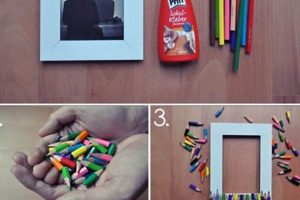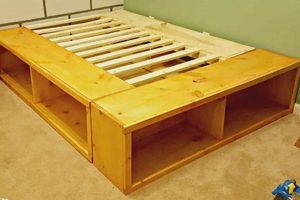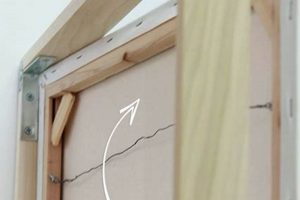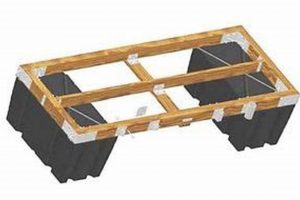The construction of sandwich boards through do-it-yourself methods represents a cost-effective and customizable approach to signage. These freestanding displays, traditionally shaped like an “A,” are employed to attract attention to businesses, events, or announcements. Their inherent portability and ease of assembly contribute to their widespread adoption across various sectors. An instance of this would be a local bakery creating a sidewalk display detailing daily specials.
This method offers several advantages, including reduced expenses compared to professionally manufactured signs, complete control over the design and materials used, and the opportunity to tailor the board to specific brand aesthetics. Historically, these types of signage have provided a simple yet effective means for merchants to communicate directly with potential customers in pedestrian traffic areas. The boards can be easily updated with chalk, paint, or removable adhesive graphics, allowing for timely messaging changes.
The subsequent sections will detail the materials required, construction techniques, and design considerations necessary for successful fabrication of these custom displays. Attention will be given to ensuring structural integrity, weather resistance, and visual appeal to maximize the sign’s effectiveness in attracting attention.
Considerations for Constructing Freestanding Signage
The following guidelines offer practical advice for creating durable and effective displays. Adhering to these recommendations enhances the longevity and impact of the finished product.
Tip 1: Material Selection is Paramount: Opt for weather-resistant materials such as treated lumber, exterior-grade plywood, or composite boards to withstand environmental elements. Proper sealing and painting further enhance durability.
Tip 2: Structural Integrity is Critical: Employ sturdy hinges and secure fastening methods to ensure the display remains stable, especially in windy conditions. Reinforce joints with corner braces for added strength.
Tip 3: Prioritize Legibility: Choose fonts that are easily readable from a distance. Maintain sufficient contrast between the text and background colors for optimal visibility.
Tip 4: Dimensions Should Align with Placement: Consider the available space and intended viewing distance when determining the size of the sign. Overly large or small signs may be ineffective.
Tip 5: Portability Enhances Versatility: Design the display to be easily transported and repositioned as needed. Implementing a lightweight construction and including handles can facilitate movement.
Tip 6: Weatherproofing Protects the Investment: Apply a protective coating to the surface of the display to shield it from moisture, UV rays, and other environmental factors. Regular maintenance ensures continued protection.
Tip 7: Compliance with Regulations is Mandatory: Investigate local ordinances regarding signage to ensure the display adheres to size, placement, and content restrictions. Failure to comply may result in fines or removal.
Following these guidelines will contribute to the construction of a well-made and effective freestanding display, maximizing its utility and longevity.
The subsequent sections will delve into advanced techniques and aesthetic considerations for refining the design and presentation of these displays.
1. Durability
Durability is a paramount consideration in the creation of do-it-yourself freestanding displays. A poorly constructed or inadequately protected sign will quickly degrade under exposure to environmental elements, negating its intended purpose and representing a wasted investment of time and resources.
- Material Selection and Weather Resistance
The choice of materials directly impacts the lifespan of the sign. Untreated lumber, for example, is susceptible to rot, warping, and insect infestation. Opting for pressure-treated lumber, exterior-grade plywood, or composite materials significantly enhances resistance to these damaging factors. Further protection can be achieved through the application of weather-resistant paints, sealants, and UV-protective coatings. A sign constructed with cedar wood and marine-grade varnish, for instance, exhibits superior longevity compared to one made from untreated pine.
- Structural Integrity and Joinery
The method of construction and the strength of the joinery are critical to withstanding wind, rain, and physical impacts. Weak or poorly executed joints are prone to failure, leading to structural collapse. Utilizing robust fasteners, such as screws or bolts rather than nails, and reinforcing joints with corner braces or metal plates can significantly improve stability. A sign with securely fastened hinges and reinforced corners is less likely to succumb to damage from strong gusts of wind.
- Protective Coatings and Maintenance
The application of protective coatings, such as paint, varnish, or sealant, acts as a barrier against moisture, UV radiation, and physical abrasion. Regular maintenance, including reapplication of these coatings and prompt repair of any damage, is essential for preserving the sign’s integrity over time. A sign that is periodically inspected and repainted will maintain its appearance and structural soundness for a longer duration.
- Environmental Factors and Placement
The sign’s placement significantly affects its exposure to environmental stressors. Positioning it in a sheltered location, away from direct sunlight, heavy rain, or strong winds, can reduce the rate of degradation. Consider using weighted bases or anchoring systems to prevent the sign from being blown over or displaced. A sign strategically positioned under an awning will experience less weathering than one placed in an open, exposed area.
The durability of a freestanding display is not merely a matter of initial construction but a continuous process of material selection, protective measures, and ongoing maintenance. By prioritizing these aspects, the investment in a do-it-yourself sign yields a long-lasting and effective tool for communication and advertising.
2. Visibility
Visibility is a critical attribute of any freestanding display. The primary function of a do-it-yourself A-frame sign is to convey information and attract attention, rendering visibility a non-negotiable design element. Effective visibility ensures the sign fulfills its intended purpose, maximizing its impact on potential customers or passersby.
- Font Selection and Legibility
The choice of font significantly influences the ease with which the message can be read. Simple, sans-serif fonts generally offer greater legibility, particularly at a distance. Font size must be appropriate for the intended viewing distance; smaller fonts may be illegible from afar. A sign employing a large, bold sans-serif font, such as Arial or Helvetica, against a contrasting background provides superior readability compared to a sign using a smaller, ornate font.
- Color Contrast and Visual Hierarchy
Color contrast plays a crucial role in drawing the eye and highlighting key information. A high degree of contrast between the text and background colors enhances visibility. Light text on a dark background, or vice versa, is generally more effective than using similar colors. Visual hierarchy, achieved through variations in font size and color, guides the viewer’s attention to the most important elements of the message. A sign using a bright, attention-grabbing color for the primary message, coupled with a more subdued color for supporting information, creates a clear visual hierarchy.
- Placement and Environmental Factors
The placement of the display directly affects its visibility. Positioning the sign in a high-traffic area, free from obstructions, maximizes its exposure. Environmental factors, such as lighting conditions and weather, must also be considered. A sign placed in direct sunlight may suffer from glare, reducing its visibility. A sign positioned in a dimly lit area may require illumination to ensure legibility. A sign strategically placed at a street corner, avoiding obstructions such as trees or parked cars, benefits from optimal visibility.
- Sign Size and Proportionality
The overall size of the sign must be proportional to the viewing distance and the complexity of the message. A larger sign is generally more visible from afar, but an overly large sign may appear cluttered or overwhelming. The proportions of the sign, including the ratio of text to graphics, should be balanced to create a visually appealing and easily digestible message. A sign with a well-balanced layout, where the size of the text and graphics is appropriate for the overall dimensions of the sign, promotes readability and visual appeal.
The cumulative effect of these factors determines the overall effectiveness of a freestanding display. The visibility of a do-it-yourself A-frame sign is not merely a matter of its physical presence but a carefully considered combination of design elements, placement strategies, and environmental awareness. A sign that incorporates these considerations effectively communicates its message and achieves its intended purpose.
3. Materials
The selection of materials forms the foundational element in the construction of a freestanding display. The longevity, aesthetic appeal, and structural integrity are directly determined by the composition of the chosen elements. For instance, employing untreated lumber as the primary component of a sign intended for outdoor placement precipitates premature degradation due to moisture, insect infestation, and ultraviolet exposure. Conversely, utilizing treated lumber, exterior-grade plywood, or composite materials mitigates these risks, thereby extending the lifespan of the sign. The initial investment in suitable materials yields long-term cost savings by reducing the frequency of repairs or replacements.
Furthermore, the choice of materials affects the ease of construction and the overall aesthetic of the finished product. Lightweight materials, such as thin plywood or corrugated plastic, simplify handling and assembly, but may compromise structural stability in windy conditions. Heavier materials, such as solid wood or metal framing, offer increased stability but necessitate greater physical effort and potentially specialized tools for manipulation. The surface finish of the materials also impacts the visual appeal of the sign. Smooth surfaces are conducive to painting or applying adhesive graphics, while textured surfaces may require more elaborate preparation techniques to achieve a professional finish. An example could be a restaurant opting for reclaimed wood to construct a rustic-looking sign, aligning with their brand aesthetic, while a modern boutique might choose sleek aluminum composite panels for a contemporary appearance.
In summary, the selection of appropriate materials is not merely a practical consideration but a strategic decision that influences the durability, functionality, and aesthetic qualities of a freestanding display. Improper material selection can lead to structural failure, visual degradation, and increased maintenance costs. Conversely, informed material choices contribute to a long-lasting, visually appealing, and cost-effective solution for conveying information and attracting attention. The careful evaluation of material properties, combined with an understanding of environmental factors and aesthetic goals, is essential for successful implementation of this signage method.
4. Construction
The fabrication process is intrinsic to the realization of a freestanding display. It represents the physical manifestation of the design concept, transforming raw materials into a functional and aesthetically pleasing sign. In the context of these displays, construction encompasses the selection and manipulation of materials, the assembly of components, and the implementation of techniques that ensure structural integrity and visual appeal. The quality of construction directly influences the durability, stability, and overall effectiveness. A poorly constructed display, characterized by weak joints, unstable support structures, or inadequate weatherproofing, risks premature failure and compromises the intended message.
Effective construction demands a clear understanding of joinery techniques, material properties, and structural principles. For example, the selection of appropriate fasteners, such as screws or bolts rather than nails, enhances the strength and longevity of the connections. Reinforcing corners with metal brackets or wooden gussets provides additional stability, particularly in windy conditions. Proper surface preparation, including sanding and priming, ensures optimal adhesion for paints and coatings, contributing to a professional finish and enhanced weather resistance. The use of jigs and templates can improve accuracy and consistency in the assembly process, minimizing errors and ensuring a uniform appearance. A sign constructed with precision and attention to detail demonstrates a commitment to quality and reflects positively on the message it conveys.
The success of any display relies heavily on the execution of the construction phase. From initial material selection to final assembly, each step demands careful consideration and skillful implementation. The resulting product, if constructed soundly, serves as an enduring testament to the effort invested. Furthermore, it facilitates the effective and reliable communication intended to garner attention or provide information. Conversely, inadequate construction detracts from the intended goal.
5. Design
The design phase is paramount in the fabrication of do-it-yourself A-frame signage, dictating both aesthetic appeal and functional effectiveness. Careful consideration of design elements ensures the resulting display effectively communicates its intended message and aligns with the brand identity it represents.
- Layout and Information Hierarchy
Effective layout prioritizes information delivery through visual hierarchy. A clear structure guides the viewer’s eye, emphasizing key messages and secondary details. This involves strategically placing elements, utilizing white space, and varying font sizes. A sign displaying a restaurant’s daily specials, for instance, might feature the special’s name in a large, bold font at the top, followed by a smaller description and price below.
- Color Palette and Branding Consistency
The chosen color palette influences visual impact and brand recognition. Colors should be selected to create contrast and enhance readability, while also adhering to the brand’s established color scheme. A consistent color palette across all marketing materials, including signage, reinforces brand identity and creates a cohesive message. A real estate company, for example, might use its signature blue and white colors on its “Open House” A-frame signs.
- Typography and Legibility
Typography plays a crucial role in conveying the message clearly and effectively. Simple, easily readable fonts are preferable, especially for outdoor signage viewed from a distance. Font size and spacing should be optimized for legibility in varying lighting conditions. A bakery’s A-frame sign might use a clean, sans-serif font like Open Sans for its daily bread selections, ensuring readability from the sidewalk.
- Graphics and Visual Elements
The inclusion of relevant graphics and visual elements can enhance the sign’s visual appeal and attract attention. Graphics should be high-resolution and directly related to the message being conveyed. Overcrowding the sign with too many visuals can detract from its message. A coffee shop might use a stylized illustration of a coffee cup on its A-frame sign to quickly communicate its core offering.
The design elements, when thoughtfully integrated, transform a basic A-frame structure into a compelling marketing tool. A well-designed display increases visibility, effectively communicates the intended message, and strengthens brand recognition. Failure to prioritize design considerations results in a sign that is visually unappealing, difficult to read, and ultimately ineffective.
6. Regulations
Compliance with local regulations forms an indispensable aspect of any do-it-yourself A-frame sign project. Zoning laws, municipal ordinances, and permit requirements often govern the placement, size, and content of such signage. Ignorance of these regulations can result in fines, mandated removal of the sign, or legal disputes. For example, a business that places a display in a right-of-way without proper authorization may face penalties. The specifics vary considerably depending on jurisdiction, necessitating thorough research prior to construction and deployment.
The practical implications of non-compliance extend beyond financial penalties. A poorly researched sign, even if aesthetically pleasing, may be deemed non-compliant due to size restrictions or content limitations related to advertising specific products or services. This requires the business to incur additional expenses and time to modify or completely rebuild the display. Furthermore, regulations may dictate the materials used, requiring fire-resistant materials in certain high-traffic areas to ensure public safety. Adherence to these mandates mitigates risks and ensures the longevity of the signage.
Navigating regulatory requirements presents a challenge, particularly for small businesses operating with limited resources. However, proactive investigation of local ordinances and communication with municipal authorities can prevent costly errors and ensure lawful operation. Furthermore, the use of easily modifiable materials and designs enables businesses to adapt their signage to comply with evolving regulations. The significance of understanding and adhering to regulations cannot be overstated, as it directly impacts the legality, longevity, and effectiveness of freestanding displays.
Frequently Asked Questions Regarding Freestanding Displays
This section addresses common inquiries concerning the design, construction, and legal considerations associated with the creation and utilization of freestanding displays.
Question 1: What constitutes the optimal material for ensuring the durability of a freestanding display intended for outdoor use?
Treated lumber, exterior-grade plywood, or composite materials offer enhanced resistance to environmental elements. Selection should be based on anticipated weather conditions and desired lifespan.
Question 2: How can the legibility of a freestanding display be maximized, particularly at a distance?
Employing a simple, sans-serif font with adequate character spacing and a high degree of contrast between the text and background colors ensures optimal readability.
Question 3: What structural considerations are paramount in preventing a freestanding display from being overturned by wind?
A wide base, weighted ballast, and secure fastening methods contribute to stability. In areas prone to high winds, consider incorporating anchoring systems or reducing the sign’s surface area.
Question 4: Is obtaining a permit necessary prior to deploying a freestanding display, and if so, where should inquiries be directed?
Local zoning ordinances often mandate permits for signage. Contacting the municipal planning department or local government offices clarifies specific requirements and application procedures.
Question 5: What methods can be employed to protect a freestanding display from the effects of prolonged exposure to sunlight and moisture?
Application of UV-resistant coatings and waterproof sealants shields the display from degradation. Regular maintenance, including reapplication of these protective layers, prolongs its lifespan.
Question 6: How can a business ensure that its freestanding display effectively communicates its brand identity and attracts attention?
Consistent branding elements, strategic use of color, and clear messaging tailored to the target audience contribute to a visually appealing and impactful display.
Effective planning, material selection, and adherence to local regulations are crucial for creating a functional and legally compliant freestanding display.
The subsequent section will provide a step-by-step guide to creating your freestanding display.
DIY A-Frame Sign
The preceding discussion has illuminated the multifaceted aspects of creating freestanding displays. The importance of durable materials, legible design, sound construction, and regulatory compliance has been emphasized. Strategic implementation of these elements is paramount to ensuring the creation of effective and legally permissible signage.
Businesses and individuals should carefully consider the outlined guidelines to maximize the utility and longevity of their DIY A-frame sign. Prioritizing thorough planning and meticulous execution will result in a valuable asset for communication and promotion, while neglecting these considerations invites potential complications and diminishes the sign’s overall effectiveness.







